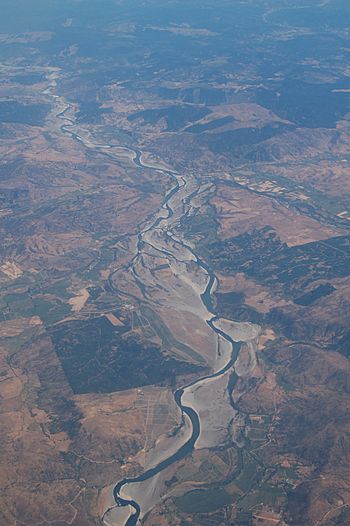Maule River facts for kids
Quick facts for kids Maule River |
|
|---|---|

Aerial view of the Maule River
|
|
| Country | Chile |
| Physical characteristics | |
| Main source | Laguna del Maule 2,200 m (7,200 ft) |
| River mouth | Pacific Ocean |
| Length | 240 km (150 mi) |
| Basin features | |
| Basin size | 20,600 km2 (8,000 sq mi) |
The Maule River (or Río Maule in Spanish) is one of the most important rivers in Chile. Its name comes from the Mapudungun language, meaning "rainy." This river has played a huge role in Chile's past, from the ancient Inca times to the country's independence and modern history.
The Maule River was once the southern border of the powerful Inca Empire. Many famous people from Chile's history were born in the Maule Region, which is named after the river. The river also gives its name to a special area where grapes are grown for Chilean wine, called the Valley of Maule. This valley is part of the larger Central Valley wine region.
Contents
Where Does the River Start?
The Maule River is about 240 kilometers (149 miles) long. Its entire river basin, which is the area of land that drains into the river, covers around 20,600 square kilometers (7,954 square miles). A big part of this basin, about 30%, is located high up in the Andes Mountains.
The river begins its journey at a lake called Laguna del Maule. This lake is in Talca Province, high up at an altitude of 2,200 meters (7,218 feet), close to the border with Argentina. From there, the Maule River flows towards the west.
Soon after it starts, another important river joins it. This is the Melado River, which flows into the Maule from its left side. The Melado River also starts in a lake, Laguna Dial, located in Linares Province. As the Maule continues its upper journey, other rivers like the Colorado, Claro, Puelche, and Cipreses also join it from the right side.
Journey Through the Middle
Before the Maule River reaches the flat central valley, its waters are held back by a large dam. This dam creates the Colbún dam lake. The water from this lake is used to power the Colbún hydroelectric power station, which generates electricity.
Further along its path, the Maule is joined by another river also called Claro (yes, there are two rivers named Claro!). Then, a very important river called the Loncomilla flows into the Maule. The Loncomilla comes from the south and has several rivers that feed into it. These include the Putagán, the Achibueno-Ancoa system, the Perquilauquén, the Purapel, and the Cauquenes.
Reaching the Ocean
In its final section, closer to the sea, the Maule River receives only one small river, the Estero de los Puercos. After flowing for nearly 250 kilometers (155 miles), the Maule River finally empties into the great Pacific Ocean. This happens just north of the city of Constitución.
Plants and Animals Around the River
The area around the Maule River is home to many interesting plants and animals. In the past, a special tree called the Chilean Wine Palm (Jubaea chilensis) grew in the Maule River basin. However, because more and more people have moved into this region, this amazing tree is now endangered. It can only be found in a smaller area, but some of the northern parts of the Maule Region are still home to these palms.
The River in Stories and Songs
The Maule River is often called Chile's most "literary" river. This means it has inspired many writers, poets, historians, and musicians. A surprising number of these creative people were born or lived in the Maule Region, which, as you know, is named after this very river.
Many stories from Latin America have used the Maule River as a main setting or even as a character itself. Books, collections of poems, and essays have described the rich culture of the area around the Maule River, sometimes called "the river of the fogs."
See also
 In Spanish: Río Maule para niños
In Spanish: Río Maule para niños
- Battle of the Maule
- Ramal Talca-Constitución
- Founding of Talca


